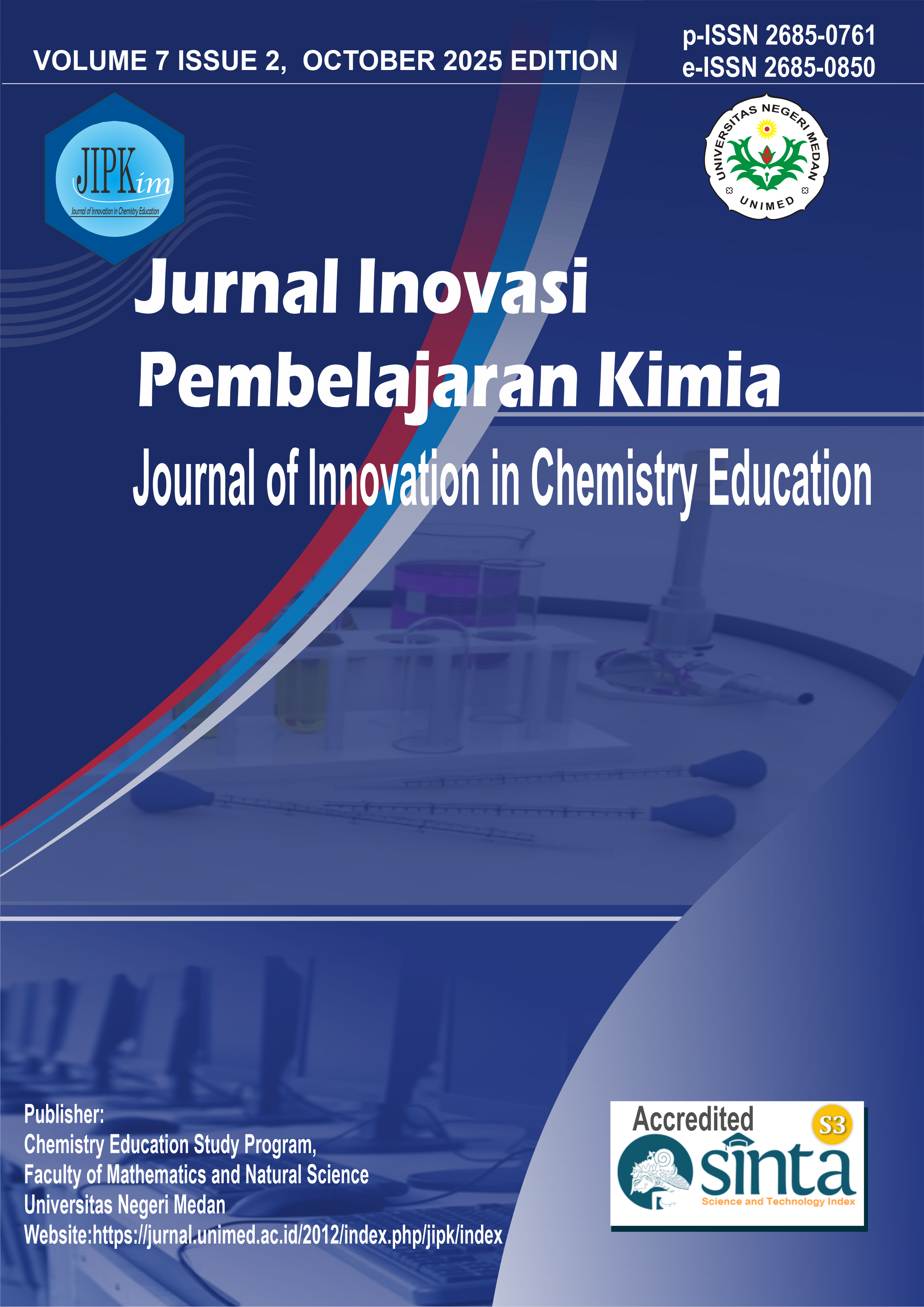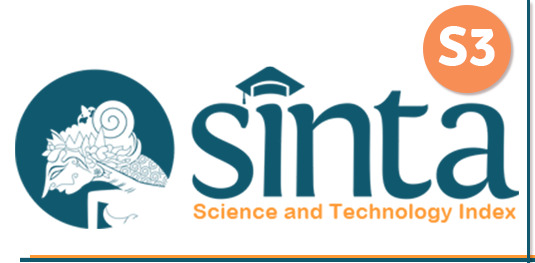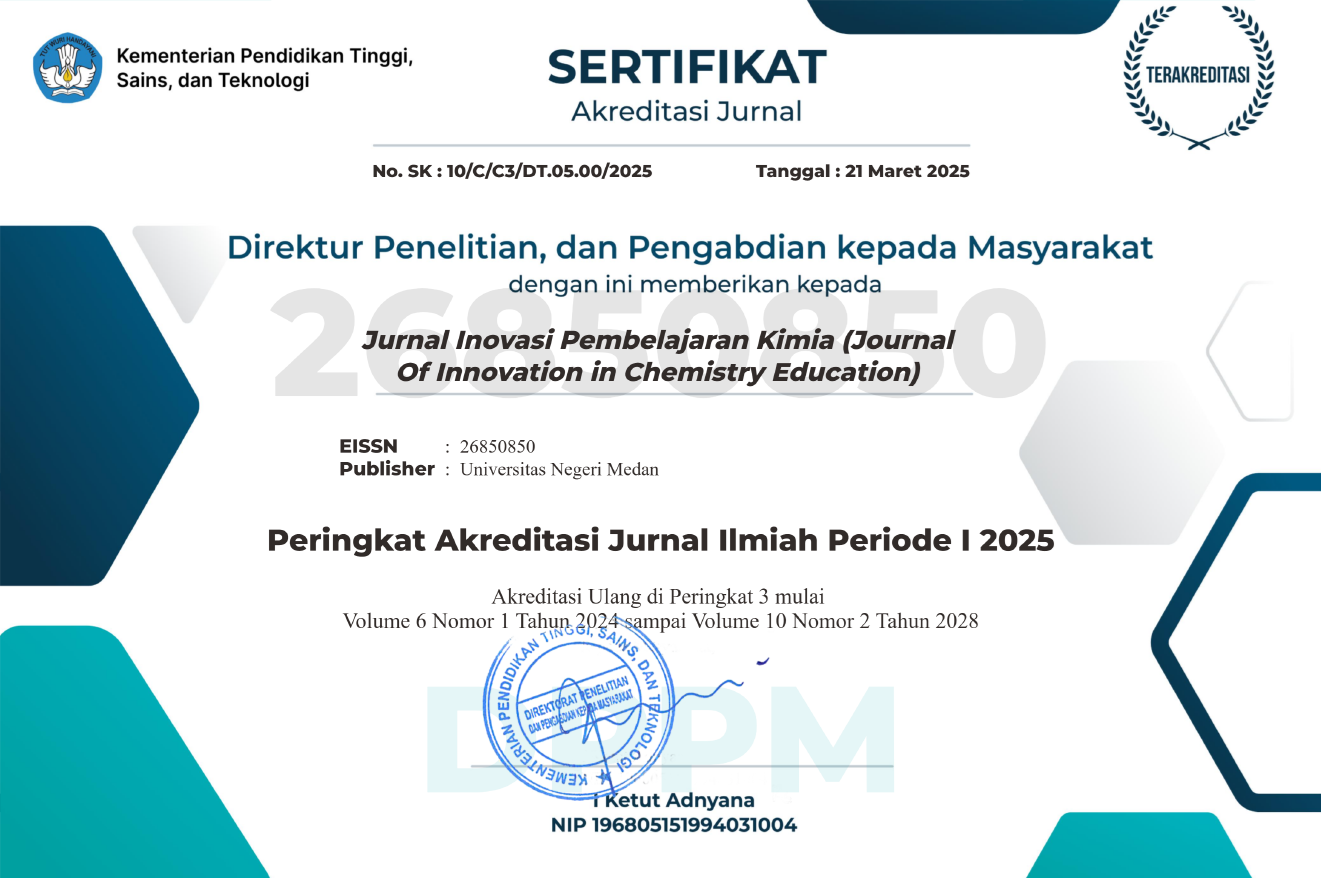The 4STMD Method for a Contextual Colloid Module on Tofu Waste Coagulation
Keywords:
Contextual Teaching and Learning, Four Steps Teaching Material Development, Colloid System, Tofu Wastewater, Moringa oleiferaAbstract
The abstract nature of chemistry often leads to low student comprehension, a problem exacerbated by a lack of teaching materials that connect concepts to real-world situations. This research aimed to develop a valid, practical, and effective contextual teaching module on the colloid system using Four Steps Teaching Material Development (4STMD) method. The research following the stages of Design, Development, and Evaluation (DDE). The module's unique context is the application of colloid chemistry principles to the treatment of tofu liquid wastewater using Moringa oleifera seeds as a natural coagulant. The development process followed the four stages of 4STMD: Selection, Structuring, Characterization, and Didactic Reduction. The module's quality was evaluated by three expert chemistry teachers and tested for understandability with 63 high school students. The results of the expert validation indicated that the module is Very Feasible, with high scores in content (95.2%), language (85.7%), presentation (93.7%), and graphical feasibility (85.3%). Furthermore, the student understandability test yielded an average score of 93.33%, categorizing the module as "High" and suitable for independent learning. It is concluded that the 4STMD method successfully produced a viable and effective contextual module that bridges the gap between abstract chemical concepts and their practical, sustainable applications.References
Adita, S., & Sugiharti, G. (2025). Development of Integrated Digital Pop-Up Book Media Using PBL Model for HOTS Science Literacy. Jurnal Inovasi Pembelajaran Kimia (Journal of Innovation in Chemistry Education), 7(1), 72–81. https://doi.org/10.22219/raden.v5i1.37064
Agil, L., & Pratiwi, D. (2015). Pengembangan Bahan Berbasis Kontekstual Pada Mata Kuliah Biologi Umum. Jurnal Pendidikan Biologi, 6(1), 23-25. http://dx.doi.org/10.24127/bioedukasi.v6i1.155
Anwar, S. (2023). Metode Pengembangan Bahan Ajar Four steps Teaching Material Development (4STMD). Indonesia Emas Group.
Arifin, A., & Anwar, S. (2016). The development of air-theme integrated science teaching material using four steps teaching material development. Jurnal Pendidikan Fisika Indonesia, 12(1), 8-18. https://doi.org/10.15294/jpfi.v12i1.4264
Berns, R. G., & Erickson, P. M. (2001). Contextual Teaching and Learning: Preparing Students for the New Economy. The Highlight Zone: Research@ Work No. 5.
Dalimunthe, M., & Ginting, R. J. (2022). Pengembangan Modul Berbasis Problem Based Learning dengan Pendekatan Saintifik pada Materi Asam-Basa. Jurnal Inovasi Pembelajaran Kimia, 4(2), 177–190. https://doi.org/10.24114/jipk.v4i2.38991
Darmilah, S., Anwar, S., & Kaniawati, I. (2025). Development of IPAS Project Modules with the 4STMD Method to Facilitate Project-Based Learning in Vocational School. Jurnal Penelitian Pendidikan IPA, 11(6), 498-508. https://doi.org/10.29303/jppipa.v11i6.11588
Firmansyah, S. (2022). Review Jurnal Pemanfaatan Biji Kelor (Moringa Oleifera) Sebagai Koagulan Alami Dalam Pengolahan Limbah Cair. Jurnal Inovasi Proses, 7(1). https://doi.org/10.36706/jip.v7i1.17143
Gustina, R. (2022). Desain dan Uji Coba Video Pembelajaran sebagai Alternatif Media Pembelajaran dimasa Pandemic dengan Pendekatan Contextual Teaching and Learning (CTL) pada Materi Asam dan Basa. Jurnal Riset Pendidikan Kimia (JRPK), 12(2), 127-134. https://doi.org/10.21009/JRPK.122.07
Gutierrez Herrera, J. C., Martínez Ovallos, C. A., Agudelo-Castañeda, D. M., & Paternina-Arboleda, C. D. (2024). Exploring moringa oleifera: green solutions for sustainable wastewater treatment and agricultural advancement. Sustainability, 16(21), 9433. https://doi.org/10.3390/su16219433
Hanum, L. (2017). Pengembangan media pembelajaran buletin pada materi hukum-hukum dasar kimia kelas x SMA/MA di Banda Aceh. Jurnal IPA & Pembelajaran IPA. https://doi.org/10.24815/jipi.v1i1.9565
Harahap, F. Z. U., & Roza, D. (2020). Pengembangan Modul Laju Reaksi Berbasis Pedagogical Content Knowledge (PCK) untuk Meningkatkan Hasil Belajar Siswa. Jurnal Inovasi Pembelajaran Kimia, 2(01), 46-50. https://doi.org/10.24114/jipk.v2i1.17853
Hasibuan, M. I. (2014). Model pembelajaran CTL (contextual teaching and learning). Logaritma: Jurnal Ilmu-ilmu Pendidikan dan Sains, 2(01). https://doi.org/10.24952/logaritma.v2i01.214
Haslinah, A. (2020). Ukuran partikel dan konsentrasi koagulan serbuk biji Kelor (Moringa oleifera) terhadap penurunan persentase COD dalam limbah cair industri tahu. ILTEK: Jurnal Teknologi, 15(01), 50-53. https://doi.org/10.47398/iltek.v15i01.510
Katayon, S., Noor, M. M. M., Asma, M., Ghani, L. A., Thamer, A. M., Azni, I., ... & Suleyman, A. M. (2006). Effects of storage conditions of Moringa oleifera seeds on its performance in coagulation. Bioresource technology, 97(13), 1455-1460. https://doi.org/10.1016/j.biortech.2005.07.031
Kepala Badan Standar, Kurikulum, dan Asesmen Pendidikan. (2022). Peraturan Kepala Badan Standar, Kurikulum, dan Asesmen Pendidikan Nomor 039/H/P/2022 tentang Pedoman Penilaian Buku Pendidikan. Kementerian Pendidikan, Kebudayaan, Riset, dan Teknologi. https://litbang.kemdikbud.go.id.
Manab, A., & Andriani, R. D. (2023, October). Effect of pH on Clotting Properties from Moringa Oleifera Seeds with Focused Microwave-Assisted Soxhlet Extraction Method as Milk Coagulant. In Proceedings of the 3rd International Conference on Environmentally Sustainable Animal Industry 2022 (ICESAI 2022) (Vol. 28, p. 391). Springer Nature. https://doi.org/10.2991/978-94-6463-116-6_49
Minata, Z. S., Rahayu, S., & Dasna, I. W. (2022). Context-Based Chemistry Learning: A Systematic Literature Review. Jurnal Pendidikan MIPA, 23(4), 1446-1463. https://doi.org/10.23960/jpmipa/v23i4.pp1446-1463
Misbah, M., Mahtari, S., Wati, M., & Harto, M. (2018). Analysis of students' critical thinking skills in dynamic electrical material. Kasuari: Physics Education Journal (KPEJ), 1(2), 103-110. https://doi.org/10.37891/kpej.v1i2.19
Omoregie, I., Anthony, H., & Braimoh, J. (2025). Comparative Analysis of Instructional Models for Designing Effective Online Courses: ADDIE, SAM, and Dick & Carey Approaches. Journal of Languages and Translation, 5(1), 33-45. https://asjp.cerist.dz/en/article/262008
Permana, E., Sumarna, O., & Anwar, S. (2023). Penyusunan bahan ajar laju reaksi berbasis konteks pembuatan pupuk organik cair dari rebung bambu dengan metode 4STMD. Jurnal Riset dan Praktik Pendidikan Kimia, 11(1), 42–64. https://doi.org/10.17509/jrppk.v11i1.57939
Purba, J., & Fitri, R. A. (2021). Pengembangan bahan ajar kimia berbasis proyek dengan multimedia pada materi alkena di sekolah menengah atas. Jurnal Inovasi Pembelajaran Kimia, 3(1), 56–60. https://doi.org/10.24114/jipk.v3i1.23536
Rahayu, A., & Jahro, I. S. (2024). Analysis of Students Problem Solving Abilities Using Contextual Learning on Colloid Material at SMAS Pertiwi. Jurnal Inovasi Pembelajaran Kimia, 6(2), 220-229. https://doi.org/10.24114/jipk.v6i2.65396
Richey, R. C., Klein, J. D., & Nelson, W. A. (2004). Developmental research: Studies of instructional design and development. In D. H. Jonassen (Ed.), Handbook of research for educational communications and technology (2nd ed., pp. 1099–1130). Lawrence Erlbaum Associates Publishers.
Rismawati, Y. (2022). Pembelajaran Kimia dengan Contextual Teaching and Learning Approach untuk Meningkatkan Prestasi Belajar Peserta Didik. Educare: Jurnal Penelitian Pendidikan dan Pembelajaran, 2(2), 27-33. https://doi.org/10.56393/educare.v1i4.1111
Ristiyani, E., & Bahriah, E. S. (2016). Analisis kesulitan belajar kimia siswa di SMAN X Kota Tangerang Selatan. Jurnal Penelitian dan pembelajaran IPA, 2(1), 18-29. https://dx.doi.org/10.30870/jppi.v2i1.431
Siregar, N. A. F., Ginting, R. J., & Silaban, R. (2024). Analysis of Problem Solving Ability in Chemistry Learning using Contextual Teaching and Learning (CTL) Model on Colloidal System Material. Jurnal Inovasi Pembelajaran Kimia, 6(2), 209-216. https://doi.org/10.24114/jipk.v6i2.65431
Sulaiman, M., Zhigila, D. A., Mohammed, K., Umar, D. M., Aliyu, B., & Abd Manan, F. (2017). Moringa oleifera seed as alternative natural coagulant for potential application in water treatment: A review. J. Adv. Rev. Sci. Res, 30(1), 1-11. https://www.akademiabaru.com/doc/ARMSV30_N1_P1_11.pdf
Slavin, R. E. (2011). Psikologi pendidikan teori dan praktik. Indeks.
Whitten, K. W., et al. (2014). Chemistry (10th ed.). Brooks/Cole, Cengage Learning.
Zumdahl, S. S., & Zumdahl, S. A. (2018). Chemistry (9th ed.). Cengage Learning.













